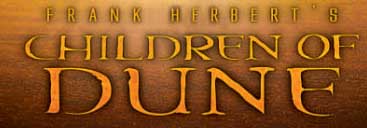

FRANK HERBERT’S CHILDREN OF DUNEA BRAVE NEW DIGITAL WORLDMounting an enormous production like Frank Herbert's Children of Dune - with its sheer scale and tight production schedule - forced the producers to find innovative ways in which to improve and ensure efficiency. To that end, explains Associate Producer Michael Messina, "Richard [Rubinstein] was adamant that we take advantage of all the technological advancements that were available to us." The first major decision was to shoot in HD instead of film. According to Producer David Kappes, "Once we did our research, which included viewing several TV shows and feature films that have been shot with Panavision's version of the new Sony 24p camera, we decided to be the first event miniseries to shoot in HD 24p. We anticipated the biggest benefit of going digital would be in time saved. We were right. We saved more than an hour a day on-set because we were not waiting for magazine changes on the camera. The presence of the HD monitor on the set was another big asset. You can see exactly what it is that you're getting, as opposed to the more traditional method of waiting for the dailies from the lab. If something wasn't right, we could re-shoot it right then and there. We also ran a separate deck on the set that we used to record all of the director's selected takes. This way we walked off the set every day with a master for the dailies. This greatly sped up our ability to get footage to Richard whenever he was in New York and to the SCI FI Channel execs in L.A. From a post/effects standpoint, shooting in HD eliminated the need to 'scan' the film to a digital format for Ernie Farino's VFX team to integrate with CGI, which saved both time and money." Regarding the distribution of the dailies, Messina adds, "Since we were walking off the set each night with a video tape, we used a company called PicturePipeline to convert the footage to MPEG-2, send it overnight to New York City via broadband, then output it back to video tape in the morning and have it available for screening at our offices by 11am. We would then overnight copies to the network execs in L.A. The production was able to get feedback while it was still useful - sometimes before a scene was completed, or before we moved to another stage or set." The production also employed cutting edge technology on an administrative level. "We took advantage of two new products from an innovative company called Movie Magic," says Kappes. "Virtual Production Office (VPO) is basically a well organized ftp site which allowed us to upload all of the production paperwork from Prague on a daily basis. Then, via username, we gave access to the information to all the executives, key crew and personnel - no matter where they were geographically. This eliminated the need for the production office to send out hardcopies of things like daily call sheets and production reports to New York, L.A., and Germany. The files were all on the Web and could be downloaded as needed. "This process was aided by the use of Movie Magic's Wireless AD. Wireless AD had been used before on a few smaller shoots, but it had never been put to the test of an eighty-day shoot or put in the hands of an international crew. We were able to give Movie Magic essential feedback that ultimately helped them improve the product. Basically, Wireless AD is a computer tablet that allows the AD's to create a variety of production paperwork, like call sheets, more easily, and beam the information right to the VPO website." Rubinstein adds, "The VPO site was especially useful for those of us who travel a lot. You did not have to rely on making sure you had a hard copy or even an electronic copy of a file with you. If you had Internet access, you were only a few keystrokes away from all of the production paperwork." Cutting edge technology was by no means used solely during principal photography. The post-production of the show also incorporates some new technologies to make things more efficient. Editor Harry Miller notes, "This time around, editorial shares a server with the VFX team. This allows us to pass shots back and forth to one another much more quickly and efficiently." Farino adds, "Area 51's Tim McHugh has basically invented a new way of rendering effects for HD, which is saving us loads of time." Composer Brian Tyler has also jumped on the technology bandwagon. Rubinstein notes, "I was in Prague and stopped by the recording studio as Brian was recording a section of the score with the Prague Symphony Orchestra. I knew Brian was in L.A. and was supervising via remote, but when I got there I was amazed to see just how well it worked. Brian was able to supervise the entire recording by the 80-piece orchestra in 'real-time' via satellite. We could see him on a video monitor and vice versa."
|
